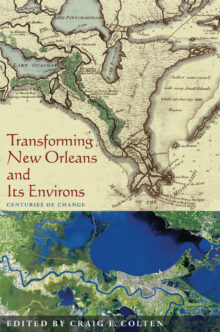
Craig Colten
Craig Colten hails from Louisiana and lived for ten years near the banks of the Mississippi River while attending college in Baton Rouge and teaching in New Orleans. Since completing his Ph.D. at Syracuse University in 1984 he has pursued topics on human transformation of the environment with a focus on industrial pollution. After a stint at Southwest Texas State University, he has recently returned home and teaches geography and anthropology at Louisiana State University.
Transforming New Orleans and Its Environs
Centuries of Change
Human settlement of the Lower Mississippi River Valley—especially in New Orleans, the region’s largest metropolis—has produced profound and dramatic environmental change. From prehistoric midden building to late-twentieth century industrial pollution, Transforming New Orleans and Its Environs traces through history the impact of human activity upon the environment of this fascinating and unpredictable region.
In eleven essays, scholars across disciplines––including anthropology, architecture, history, natural history, and geography––chronicle how societies have worked to transform untamed wetlands and volatile floodplains into a present-day sprawling urban center and industrial complex, and how they have responded to the environmental changes brought about by the disruption of the natural setting.
This new text follows the trials of native and colonial settlers as they struggled to shape the environment to fit the needs of urbanization. It demonstrates how the Mississippi River, while providing great avenues for commerce, transportation, and colonization also presented the region’s greatest threat to urban centers, and details how engineers set about taming the mighty river. Also featured is an analysis of the impact of modern New Orleans upon the surrounding rural parishes and the effect urban pollution has had on the city’s water supply and aquatic life.

